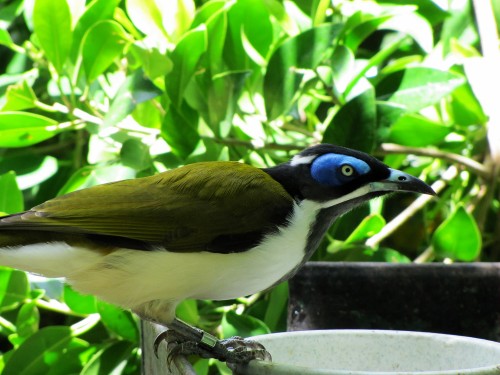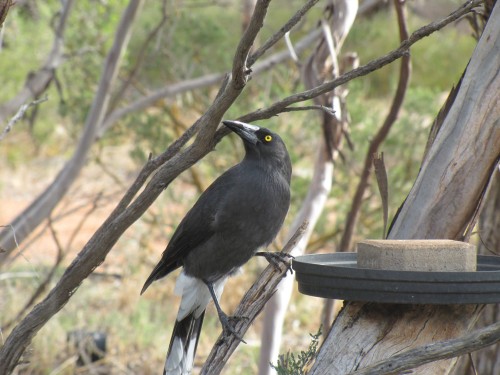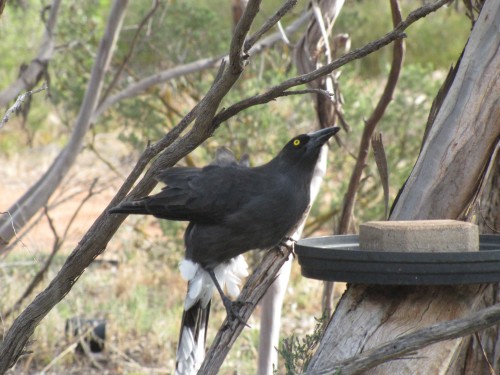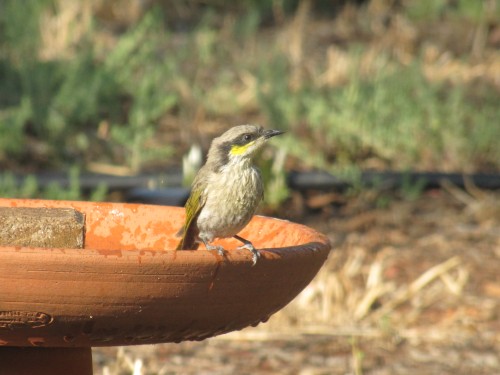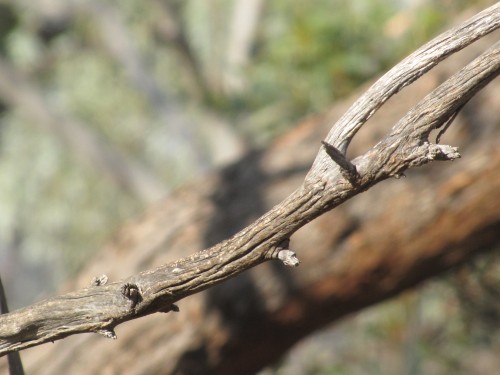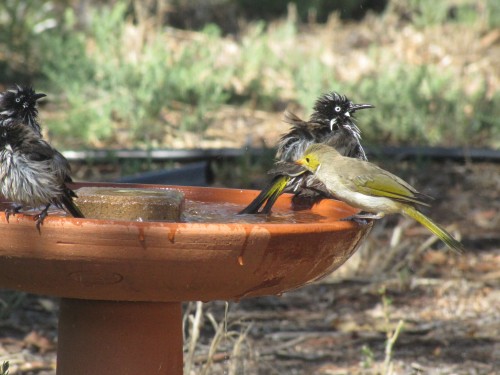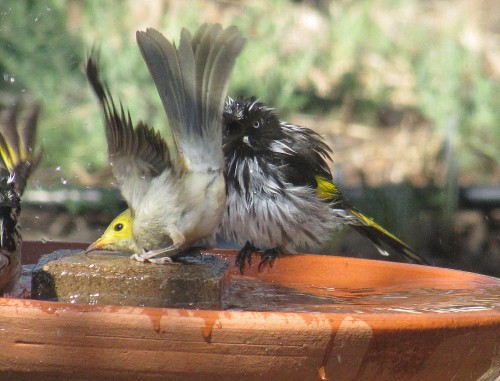The chase is on
A little while ago I was outside in the garden attending to one of those mundane jobs around the house. Okay, I’ll admit I was checking the washing hanging out to dry. My attention was suddenly grabbed by a great uproar coming from the local resident honeyeaters. They were creating a terrible noise, so I knew that something was disturbing them big time.
As I looked around a Collared Sparrowhawk (see photo above) landed on the power line coming in towards the house. Next thing, it took off after its lunch – a Common Starling. Well, I’m not sure if it actually caught its prey. The last I saw of them was the starling zooming a full speed across the garden and then weaving through the mallee scrub behind our house, hotly pursued at full speed by the hawk. I was amazed at how fast they were going, but when you consider those sharp talons, one can hardly blame the starling for getting a move on.
Blue-faced Honeyeater, Adelaide Zoo
The first time I focussed my binoculars on a Blue-faced Honeyeater I was amazed at the brightness of its blue face. It was one of those special moments we sometimes get while birding.
As a result of that first great encounter, I enjoy every subsequent observation of this species. On the downside, not every sighting is as good as the one I had earlier this year in one of the walk through aviaries at the Adelaide Zoo here in South Australia. Being a captive bird quite at ease with hundreds of visitors to its home daily, this bird was quite happy to pose for me – or was it just too hungry to fly away. Note the identification band on the right leg.
The Blue-faced Honeyeater is found along coastal northern and eastern Australia, often found far inland from the coast where there is suitable habitat. In south eastern parts of our country it is more of an inland bird, generally avoiding the higher altitudes in Victoria and southern New South Wales.
Its preferred habitats include open forests, watercourses, woodlands, orchards, parks and gardens and farmlands.
For more of my photos of this species and another article click here.
Grey Currawong at the bird bath
When moved to our current home and five acre block nearly 30 years ago. Over that time I have recorded over a hundred different species that have visited or flown over. About 40 of those are resident – meaning they can be seen most days – and most of those have been recorded breeding here.
The locally common Grey Currawong was a notable species absent from my lists for several decades. We would occasionally hear one calling in the distance up the hill about a kilometre away. This is an area of thick mallee scrub. They rarely ventured down into our garden.
That all changed about ten years ago. Now this species is a frequent visitor in our garden and we see or hear one or more every few days. I still wouldn’t call it a resident species, though. On a few occasions a local breeding pair have brought their recently fledged off-spring to visit too.
Even rarer is a visit to one of our bird baths, but this, too, is changing. Last week I managed a few good photos of one bird as it was drinking. Those bright yellow eyes are quite penetrating, and I am not surprised that smaller birds – like the thornbills and honeyeaters – get very nervous when the currawongs are around, sending out warning calls. That large beak would easily gobble down a nestling by the look of it.
Singing Honeyeater at the bird bath
Over recent days I have shared some of the photos of birds seen during our recent hot spells of weather. Our bird baths are popular with the resident bird population and we can observe anything up to a dozen species in a ten minute period. Bird Bath Central can get both busy – and noisy.
One of the quieter species to come for a drink would have to be the Singing Honeyeater. They come individually – and occasionally in twos and threes – and never make a great fuss. certainly not like the gregarious New Holland Honeyeaters. I have observed that they tend to come when no other birds are around. The much larger Red Wattlebirds and Australian Magpies are the usual dominant birds, bossing the other species away.
And then we get those interesting birds like that not shown in the photo below. Sometimes the birds are just too quick for my camera. I must make a collection of photos of rocks, twigs, branches and fence posts showing where a bird has just been – but escaped before the shutter was released.
White Plumed Honeyeater comes for a bath
Over recent days I have been writing about and showing photos of various birds coming to visit our birdbath. Usually the New Holland Honeyeaters dominate proceedings, making a terrible din and splashing water everywhere.
On this occasion a solitary White Plumed Honeyeater forced its way in , running the gauntlet of the mob. I am not sure what it is doing in the photo below. Almost seems like it has landed awkwardly. It’s probably just flapping its wings and I caught it in an unusual pose.

